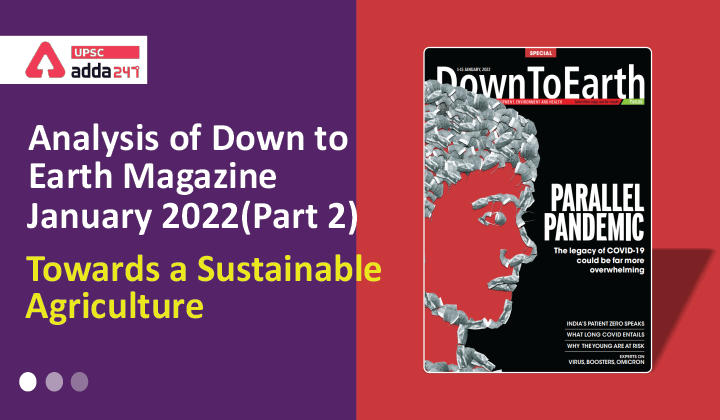Table of Contents
Analysis of Down to Earth Magazine: Towards a Sustainable Agriculture
Relevance
”GS 3: Sustainable Agriculture, Environmental Pollution & Degradation”
Introduction
- While Indian agriculture is adversely impacted by the vicissitudes of climate change, the sector also is a significant contributor to greenhouse gas (GHG) emissions.
- As per the Third Biennial Update Report submitted by India to the United Nations Framework Convention on Climate Change in early 2021, the agriculture sector contributes 14 per cent of the total GHG emissions (energy 75.01 per cent; industrial process and product use 8 per cent; and waste 2.7 per cent, as per 2016 data).
- Within the sector, 54.6 per cent of GHG emissions were due to enteric fermentation, followed by 17.5 per cent from rice cultivation, 19.1 per cent from fertiliser applied to agricultural soils, 6.7 per cent from manure management, and 2.2 per cent due to field burning of agricultural residues.
- Therefore, effective mitigation measures and appropriate adaptation technologies must be taken to reduce GHG emissions from the agriculture sector.
What is INDIA’S pledge of Panchamrit?
- India’s pledge of panchamrit (five-fold strategy) to fight climate change, announced during the 26th Conference of the Parties (cop26) at Glasgow, Scotland, has caught global attention.
- The country’s new commitments include reaching 500 GW of non-fossil fuel energy capacity by 2030; producing 50 per cent of energy requirements via renewable energy sources by 2030; a reduction of 1 billion tonnes of carbon by 2030; reducing the carbon emission intensity of the GDP by 45 per cent by 2030; and most importantly, achieving net-zero emissions by 2070.
What is Sustainable Agriculture Policy Action Agenda?
- This Policy Action Agenda sets out pathways and actions that countries can take to repurpose public policies and support to food and agriculture.
- India and 26 other countries signed the Sustainable Agriculture Policy Action Agenda at the COP 26 summit to set a course of action to protect food systems and prevent loss of biodiversity against climate change.
What is National Mission on Sustainable Agriculture?
- As part of the National Action Plan on Climate Change has, for more than a decade now, focused to make Indian agriculture sustainable, considering likely risks arising from climate variability.
- Moving towards climate-smart agricultural technologies and approaches to assist the sector to become less vulnerable to the adverse impacts of climate change.
What should be done to make Indian agriculture sustainable in a changing climate?
-
Crop Diversification
-
Agro-ecological approaches
-
Water-use efficiency
-
Renewable energy usage
-
Digital agriculture
-
Research and innovation investments
Way Forward
- Inadequate and sub-optimal investments may not yield desired results and the government must commit enhanced outlay for agricultural research and innovation, including improvement of infrastructure, and capacities of both scientists and extension personnel.
- Climate change affects the poor and the smallholders, who earn their livelihoods from agriculture, disproportionately.
- Technologies and adaptation strategies must, therefore, reduce their vulnerabilities.
- India, in its mitigation and adaptation efforts, must implement policies that make agriculture climate-resilient and sustainable.
- Post-cop26, India’s ambitious commitments should reflect in its tangible and concrete actions.
Conclusion
India’s approach should be a balancing act between growth and sustainability in its climate change policies and it should be leading the developing nations to place sustainable agriculture on its top priority.



 TSPSC Group 1 Question Paper 2024, Downl...
TSPSC Group 1 Question Paper 2024, Downl...
 TSPSC Group 1 Answer key 2024 Out, Downl...
TSPSC Group 1 Answer key 2024 Out, Downl...
 UPSC Prelims 2024 Question Paper, Downlo...
UPSC Prelims 2024 Question Paper, Downlo...
